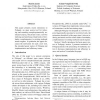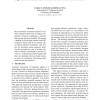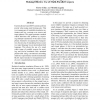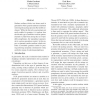ACL
2007
14 years 1 months ago
2007
Language model (LM) adaptation is important for both speech and language processing. It is often achieved by combining a generic LM with a topic-specific model that is more releva...
ACL
2007
14 years 1 months ago
2007
In order to effectively access the rapidly increasing range of media content available in the home, new kinds of more natural interfaces are needed. In this paper, we explore the ...
ACL
2007
14 years 1 months ago
2007
This paper presents recent extensions to Poliqarp, an open source tool for indexing and searching morphosyntactically annotated corpora, which turn it into a tool for indexing and...
ACL
2007
14 years 1 months ago
2007
We apply pattern-based methods for collecting hypernym relations from the web. We compare our approach with hypernym extraction from morphological clues and from large text corpor...
ACL
2007
14 years 1 months ago
2007
Many automatic evaluation metrics for machine translation (MT) rely on making comparisons to human translations, a resource that may not always be available. We present a method f...
ACL
2007
14 years 1 months ago
2007
We present a formalization of dependency labeling with Integer Linear Programming. We focus on the integration of subcategorization into the decision making process, where the var...
ACL
2007
14 years 1 months ago
2007
Current phrase-based SMT systems perform poorly when using small training sets. This is a consequence of unreliable translation estimates and low coverage over source and target p...
ACL
2007
14 years 1 months ago
2007
Surface realisers divide into those used in generation (NLG geared realisers) and those mirroring the parsing process (Reversible realisers). While the first rely on grammars not...
ACL
2007
14 years 1 months ago
2007
Recently, confusion network decoding has been applied in machine translation system combination. Due to errors in the hypothesis alignment, decoding may result in ungrammatical co...
ACL
2007
14 years 1 months ago
2007
This paper describes the first system for large-scale acquisition of subcategorization frames (SCFs) from English corpus data which can be used to acquire comprehensive lexicons ...




